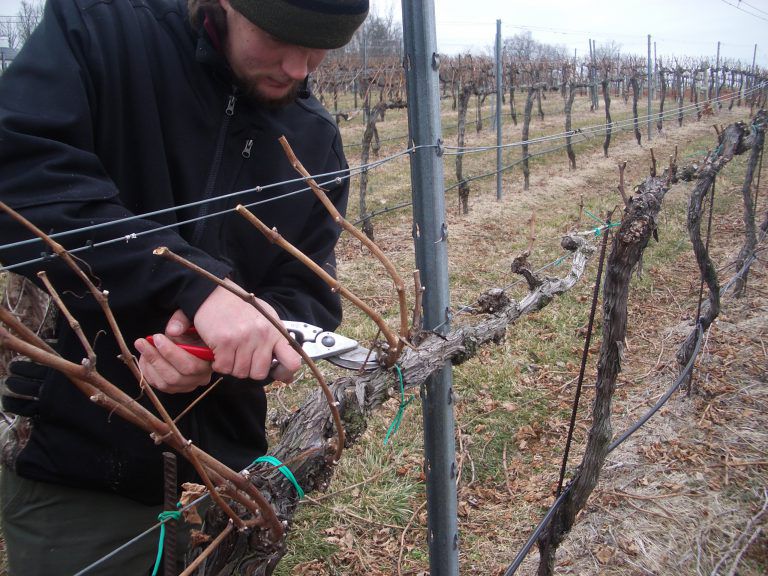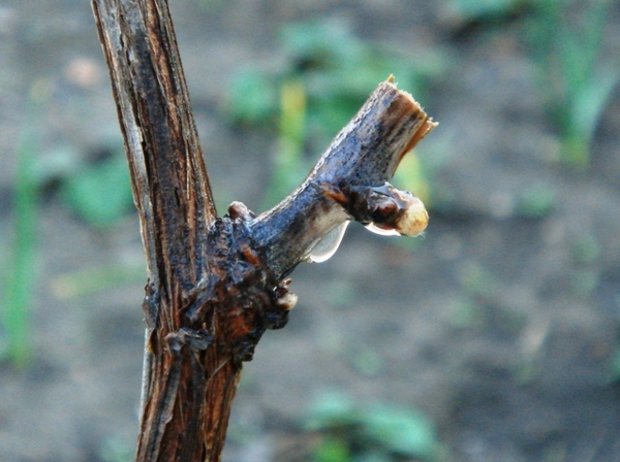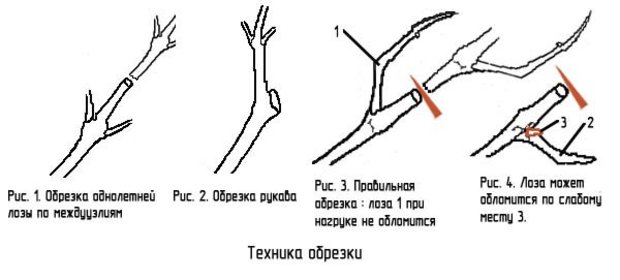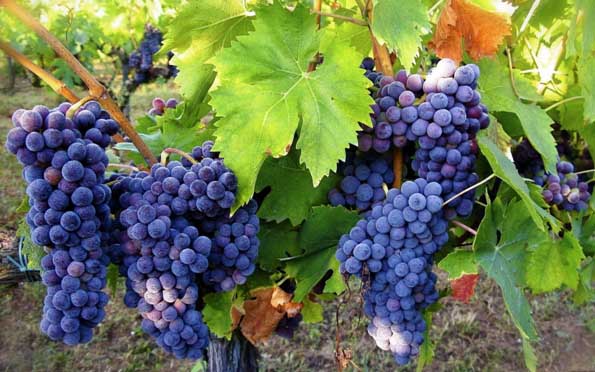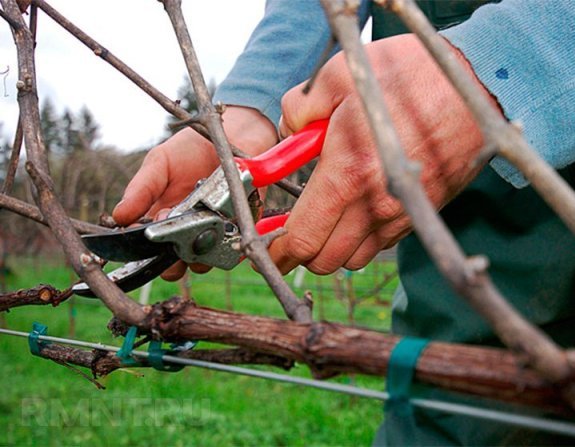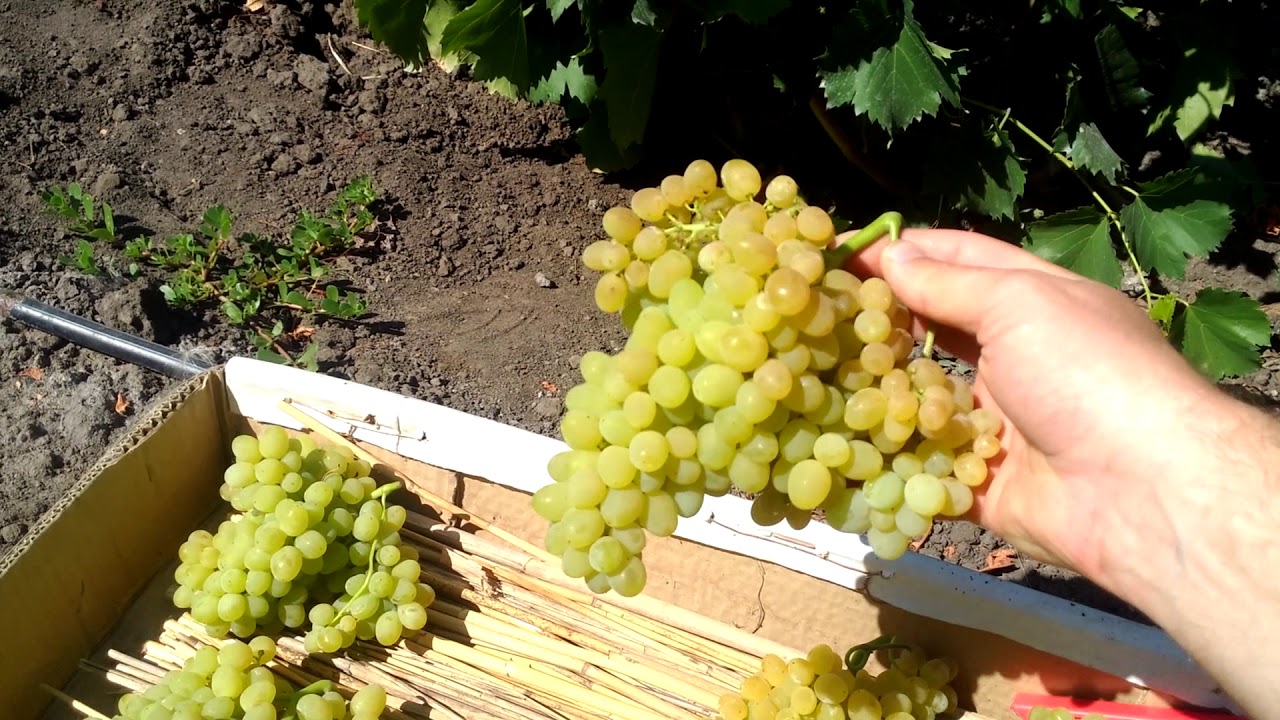Grapes are a capricious culture that requires careful maintenance. Paying close attention to each bush, you can hope for a rich harvest. One of the key points of care is pruning. It is carried out for young and old bushes, performed in spring or autumn.
Content
Why crop is needed
Polarity is inherent in grapes. It lies in the fact that the nutrients obtained from the soil, the plant continuously directs upward, to the tips of the branches. Therefore, the further the shoot is from the root, the better it develops. This property ensures the rapid growth of the grapes up and to the sides, while simultaneously exposing the lower part of the bush, which lacks nutrients.
In the absence of plant care, its fruits become small and sour. Such a vine is called "neglected" or "run wild", and one does not expect a good harvest from it. Timely pruning of the bush will prevent all these troubles. But you need to know how to do it correctly and when.
When to do it: in spring or autumn?
There is no consensus among winegrowers as to when is the best time to prune, in spring or fall. But there are recommendations of experts who claim that in regions with a harsh climate it is preferable autumn pruning of grapes, and in warm climatic zones - spring.
In order to independently understand this issue, it is necessary to understand that with the first thaws, the property of polarity begins to act in the plant, forcing nutrients to move in the direction from the roots. In the second half of October, the vine goes into a state of dormancy and a reverse movement of the juices is observed - from the tips of the branches to the base of the bush.
Opponents of autumn pruning insist that it weakens the plant. If you shorten the vine during the dormant period, its lower root part will not receive enough nutrients necessary for wintering: they will remain in the cut branches.
Supporters of autumn pruning claim that it is the most gentle, as it reduces the intensity of the "spring cry" of the vine. So called sap, the movement of sap in the branches, drops of which appear on their surface. This is an undesirable and even dangerous phenomenon for fruiting. It can lead to several unpleasant consequences:
- wetting and decay of the kidneys;
- defeat by fungal infections;
- decrease in yield;
- drying of shoots.
The spring "cry" of grapes is regarded in different ways. Some gardeners consider it a sign of good activity of overwintered roots. Others see the juice yield as weakening the bush and insist that pruning the grapes in spring strengthens the plant and makes it more hardy.
Experienced growers follow a few rules.
- Vines that are not covered for the winter are pruned in the spring.
- Bushes requiring insulation are pruned in the fall.This is due to the fact that grapes that have grown over the year are difficult to cover. This requires a lot of covering material and is difficult to do.
- Bushes over 4 years old are pruned in spring and autumn.
When pruning in autumn, it is taken into account that some buds (eyes) may die during the winter. Therefore, they are left with a margin of several eyes. In the spring, the situation is assessed and the bush is corrected.
It is very important to follow the plan for planting new plants. Grapes do not tolerate transplanting, so they plant it once for a long time:https://flowers.bigbadmole.com/en/yagody/vinograd/kak-posadit-vinograd.html
Basic rules for work for beginners
- The vine is pruned until the buds swell. That is, until the moment when an intensive movement of juice begins in it.
- Remove all old and damaged branches.
- All young shoots are pruned, leaving 2-3 eyes on them.
- On first-year shoots, it is necessary to leave 12-15 mm of wood.
Pruning grapes in different regions of Russia: a table of recommendations
Regardless of the region of growth, the grapes are pruned at the most favorable air temperature for this purpose. In areas with a southern climate, it is established earlier than in northern ones. Therefore, the calendar dates for vine care vary.
| Moscow / Moscow region | Ural | Kuban | |
| Spring pruning terms and conditions | At an average daily temperature of + 5 ° C. | The second or third decade of March, at a temperature of + 5–7 ° С. | In the beginning of March. |
| Terms and conditions of autumn pruning | At an average daily temperature of -3–5 ° С. | Second to third decade of November, before frosts. | In the middle of September. |
| The optimal period for the lunar calendar | For pruning bushes up to 3 years old, the best pruning time is a young moon. In all other cases, it is decreasing. | ||
Care for old and young grapes
There are many similarities in caring for old and young grapes, but there are also differences. In order to do everything on time, a novice gardener needs to remember simple rules.
- One of the goals of pruning is to give the bush a shape that is most convenient for shelter for the winter.
- The guarantee of a good harvest next year is a ripe vine in the current one and overwintered eyes. This is taken into account when pruning in autumn.
The nuances of caring for young grapes
The main task of the spring pruning of a young bush is to create conditions for the unhindered formation of a pole shoot. During the warm season, the vine should get stronger. They help her in this by tying a peg to a trellis or hammered next to the base of the bush.
In the first year of the plant, it is recommended to remove all emerging inflorescences. Young grapes will not yield a good harvest and large berries. Ripening fruits will take away the strength and nutrients from the plant that are necessary to strengthen the young vine and increase its yield next year.
In the first two years of the vine's life, caring for it consists in forming a powerful bush and preparing it for fruiting. During the entire growing season, pinching is performed over the second and third leaves.
Growing grape seedlings in the conditions of central Russia:https://flowers.bigbadmole.com/en/yagody/vinograd/vyirashhivanie-vinograda-v-sredney-polose-dlya-nachinayushhih.html
The nuances of caring for old grapes
Experienced winemakers in the care of old grapes carry out not only spring and autumn, but also summer pruning.
It is necessary to remove the top inflorescences and bunches, leaves and shoots. This is due to the peculiarity of mature plants, the fruits of which are concentrated in the lower part of the bush. And with the outflow of nutrients upward, to the ends of the branches, the lower, fruiting part of the bush weakens. Summer pruning is done without pruning shears.
In caring for old grapes, special attention is paid to autumn pruning. It is performed in several stages.
- Before the onset of freezing temperatures, while the vine still has leaves, new shoots and "old sleeves" are removed.The strongest branches are cut to 1/10 of their length.
- After the foliage has fallen off, the process of preparing for winter begins and the movement of the juices in the opposite direction - from the tips of the branches to the root. The purpose of pruning in the fall is to remove all powerful shoots that have formed this season. This process has its own name: "replacement knot formation". To do this, 3-4 buds are left in the lower part of powerful shoots, the rest is cut off. On younger shoots, 5-6 eyes are left (2-3 of them are spare).
- By the beginning of the third year, there should be 4 formed vines on the bush. In the spring they are cut off, leaving 2 buds each. During the summer, each will give an escape. Throughout the warm season of the year, branches growing from replacement buds are removed.
- Grapes of the 4th year require the formation of 2 vines on each arm. To do this, when pruning, 8-10 buds are left on each shoot.
Formation of shrubs of covering and non-covering types
Formation of grapes of any variety begins in the first year of planting and lasts for 4-6 years. The process requires several steps:
- trimming;
- garter sleeves and shoots;
- topping;
- breaking out unnecessary shoots.
The molding is considered complete after the creation of a branched bush skeleton, each branch of which has fruit wood. Thus, they provide stable fruiting and high yields. Further care of the bush is to maintain its shape. For this purpose, in the fall, remove up to 90% of the growth that has appeared in the current season.
There are several types of grape formations, but they all belong to one of two categories:
- covering;
- non-covering.
The former are chosen for varieties that require shelter for the winter due to the characteristics of the plant or the climate of the region. Non-covering formations are needed for the corresponding varieties: non-covering. Every grower must choose the right way to create a powerful bush. In order to exclude a mistake, they are guided by the recommendations of experienced winemakers.
Popular shaping methods
- Fan. It consists in creating such a skeleton of a bush in which each fruit link is located on its own sleeve, coming from the root of the plant. This principle is respected regardless of the number of branches and their length. Fan-shaped is the simplest and most popular method of forming grapes.
- Cordonnaya. The second most popular method consists in creating several short sleeves (each of which has a fruit link) on powerful and long "shoulders". There are two types of cordon formation: horizontal and vertical. Either method produces a powerful shrub with a large volume of perennial wood.
- Arched. It is mainly used to form gazebos, arches and landscape design elements. It is a type of vertical cordon with trellis elements.
- Unsupported standard. The purpose of the process is to create a high vertical trunk (trunk), in the upper part of which there are sleeves with fruiting arrows.
The vines begin to tie up after the threat of strong spring frosts has passed, at the beginning of sap flow, but before the buds open:https://flowers.bigbadmole.com/en/yagody/vinograd/kak-podvyazyvat-vinograd-vesnoy.html
Method selection rules
The choice of the method of forming a bush depends not only on the grape variety. Of great importance is the distance chosen by the gardener for planting the bushes and the width of the row spacing. The more these indicators are, the more powerful shaping method you can choose. Beginners are advised to focus on proven practice recommendations.
- For regions with a cold climate, where covering varieties are grown, three methods of formation are most favorable: horizontal cordon, fan, sleeveless capitate type.
- If the distance between the bushes is at least 3 m, a horizontal cordon is recommended.
- If the distance between the bushes is less than 3 m, a four-arm fan is the best choice.
- If the distance between the bushes is less than 1.5 m, choose a two-armed fan or a sleeveless formation.
- For regions with a warm climate, any method of forming bushes is possible.
Step-by-step instructions for pruning grapes
To perform pruning, you will need a special tool - a pruner. Its blades must be sharply sharpened, which will exclude excessive injury to plants. In order for the work to be most effective, the pruner must be comfortable in the hand.
Trimming rules:
- the cut is made perpendicular to the branch;
- leave the number of buds required for the selected method of forming a bush;
- perennial lily branches are removed carefully, leaving a "stump" 7–10 mm high;
- for fruiting, shoots are left with a thickness of at least 6 mm;
- remove all shoots with a thickness of 10 mm or more.
Cutting scheme for standard forming:
- In the spring of the first year, the shoot is cut off, leaving two eyes.
- In the spring of the second year, the strongest shoot of the two is chosen and left to form a stem. Cut off, leaving a branch 50–80 cm long. The second shoot is cut to 2 eyes.
- In the spring of the third year, only the two upper vines are left, cutting them to 2 eyes.
- In the spring of the fourth year, all fruiting branches are cut. Form fruit links from shoots on replacement knots. On the most powerful shoot 6–12 eyes are left, on the second - 2–3.
Pruning grapes in spring for beginners: video
Grapes of any variety do not need any additional maintenance after pruning. If done correctly, it will not harm the plant. If you follow the recommendations of experienced gardeners, you can grow powerful and abundantly fruiting bushes.
